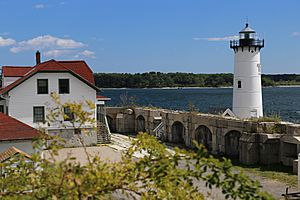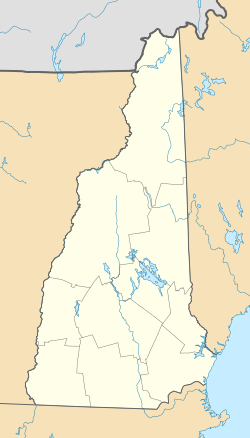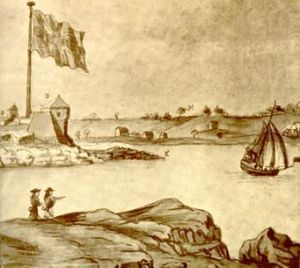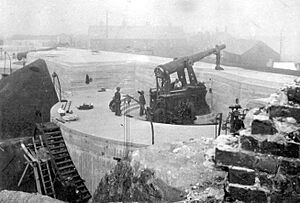Fort William and Mary facts for kids
Quick facts for kids |
|
|
Fort Constitution
|
|
 |
|
| Location | New Castle, New Hampshire |
|---|---|
| Built | Early 17th century |
| NRHP reference No. | 73000169 |
| Added to NRHP | July 09, 1973 |
Fort Constitution is a very old fort located on New Castle island. It sits at the mouth of the Piscataqua River in New Hampshire. This fort has a long history, starting even before the United States was a country!
It was first known as "The Castle" in the early 1600s. Around 1692, it was renamed Fort William and Mary after the British King William III and Queen Mary II. This fort played a big role in protecting the area.
During the American Revolutionary War (1775–1783), American rebels took control of it. Later, it was rebuilt and renamed Fort Constitution in 1808. It then helped protect the country during the War of 1812. The fort was updated again in 1899 and was active through World War II.
In 1961, the fort became a state park in New Hampshire. It was added to the National Register of Historic Places in 1973. Today, you can visit this historic site and explore its past.
Contents
Early Days: The Colonial Fort
The first fort was built by local settlers before 1632. It was like a guard for the harbor at Portsmouth. The fort reported directly to the royal governor of New Hampshire. It stored weapons and was the main seaport for the colony.
The fort also helped protect Kittery, which was across the harbor. Kittery was part of Massachusetts Bay back then. Native American tribes sometimes raided the Kittery side during the French and Indian Wars.
American Revolution: A Bold Raid
In 1774, Fort William and Mary was the only military post in New Hampshire. It was a key location for storing gunpowder and cannons.
The 1774 Raids: Taking Supplies
On December 14, 1774, something big happened. Local Patriots from Portsmouth stormed the fort. They were led by John Langdon, a local leader. The Patriots easily took over the fort from its small guard. They seized the fort's gunpowder supply. This gunpowder was then given to local militias to prepare for the fight against Great Britain.
The very next day, more rebels, led by John Sullivan, raided the fort again. This time, they worked harder to take many heavy cannons, ammunition, and other supplies. These raids were important because they showed the colonists were ready to fight for their freedom.
Fort Constitution: A New Name and Purpose
After the American Revolution, the fort was sometimes called "Castle Fort." In 1791, the new state of New Hampshire gave the land to the federal government.
Rebuilding and Renaming
In 1800, the Portsmouth Naval Shipyard was built nearby. The fort was then rebuilt as part of a new defense plan for the U.S. coast. Its brick walls were made taller, and new brick buildings were added. This work finished in 1808, and the fort was renamed "Fort Constitution."
On July 4, 1809, a sad accident happened during Independence Day celebrations. An explosion at the fort killed several soldiers and civilians.
Defending in the War of 1812
During the War of 1812, the fort was busy. It was expanded with a new tower called Walbach Tower in 1814. This tower had a large 32-pounder cannon.
Changes After the Civil War
Over 40 years later, during the American Civil War (1861–1865), there were plans to rebuild Fort Constitution. The idea was to make it a huge granite fort. However, new weapons like armored warships and powerful cannons made these old fort designs useless. So, the construction stopped in 1867. The fort kept its older design, with only parts of the new granite walls started.
Around the Civil War, four large 100-pounder cannons were placed at the fort. These cannons stayed there for many years.
Modernizing for New Threats
In the 1890s, the U.S. military started a big project to improve coastal forts. This was called the Endicott Program. Work began on Battery Farnsworth at Fort Constitution in 1897. This battery was part of a larger defense system for Portsmouth. It included nearby Fort Stark and Fort Foster.
Battery Farnsworth was built partly underground with strong concrete. It had two large 8-inch guns that could "disappear" after firing. This meant they would drop down behind a wall for protection. The battery was named after Brigadier General Elon J. Farnsworth. It was finished in 1899, after the Spanish-American War.
In 1904, Battery Hackleman was added next to it. This battery had two 3-inch guns. Its main job was to protect an underwater minefield from enemy ships. It was named after General Pleasant A. Hackleman.
World Wars and Beyond
When the U.S. entered World War I in 1917, many guns were removed from coastal forts. They were sent to Europe to help in the war. Both 8-inch guns from Battery Farnsworth were removed in October 1917.
During World War II (1939-1945), the 3-inch guns at Battery Hackleman were replaced. A mine observation station was also built on top of Battery Farnsworth. After the war, Battery Hackleman was taken apart by 1948. The fort was then given to the Coast Guard.
In 1961, Fort Constitution was given back to the state of New Hampshire. It became a state park, and Battery Farnsworth can still be seen there today. The fort was officially recognized as a historic place in 1973.
The Lighthouse

A lighthouse has stood at the fort since 1771. The lighthouse you see today is the Portsmouth Harbor Light, built in 1878. It has a special lens called a Fresnel lens that helps guide ships. You can sometimes take tours of the lighthouse and the area around it.
See also







